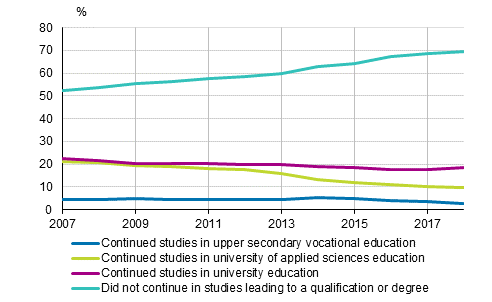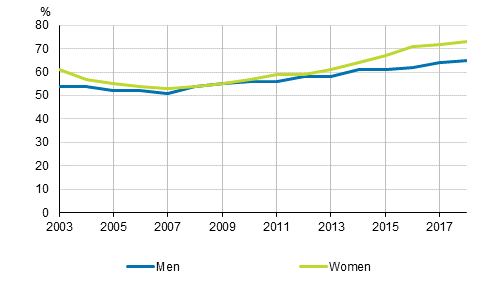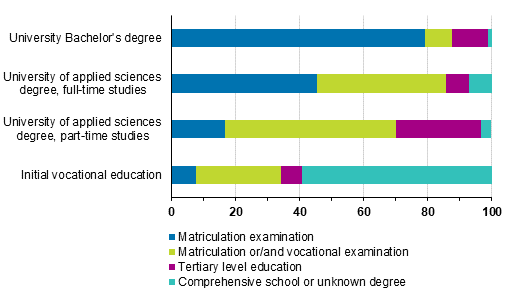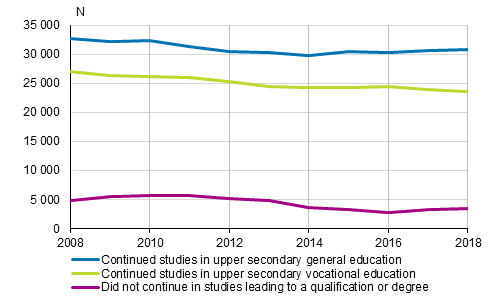Published: 12 December 2019
Share of passers of the matriculation examination left outside further studies grew further
According to Statistics Finland's education statistics, 70 per cent of those who completed the matriculation examination in the spring semester in 2018 did not continue studies leading to a qualification or degree in the year of the matriculation examination. Ten per cent of them continued in university of applied sciences education and 18 per cent in university education. The share of those left outside further studies among new passers of the matriculation examination has grown for over 10 years. Eighty-two per cent of passers of the matriculation examination applied for further studies. Of completers of comprehensive school, 53 per cent immediately continued in upper secondary general education after comprehensive school and 41 per cent in vocational education.
Direct transition to further studies of passers of the matriculation examination in the spring semester 2007–2018, %

The share of those who received a place for further education at a university grew slightly from the previous year. Because the share of those continuing to vocational and university of applied sciences education continued to decrease, the number of new passers of the matriculation examination left outside further education grew by 0.7 percentage points from the previous year. Ten years previously, 20 per cent immediately continued their studies in university of applied sciences education, when only close on ten per cent of passers of the matriculation examination did so in 2018.
Passers of the matriculation examination, who did not continue studies leading to a qualification or degree by gender 2003–2018, %

In recent years, the share of new female passers of the matriculation examination remaining outside further education has increased more sharply than that of male passers. In 2018, altogether 27 per cent of women who passed matriculation examination in the spring semester and 35 per cent of male passers immediately continued their studies, while ten years earlier, the share for both sexes was slightly over 46 per cent. Male passers of the matriculation examination continued more often than women in university and university of applied sciences education, 34 per cent of men and 24 per cent of women started tertiary level studies.
Four out of five of those who passed the matriculation examination in the spring semester applied to further education in the year of the matriculation examination. Eighty-one per cent of new passers of the matriculation examination in 2018 applied to tertiary education, 82 per cent of women and 80 per cent of men. Forty-eight per cent of passers of the matriculation examination applied only to university education and 17 per cent only to university of applied sciences education. Sixteen per cent of new passers of the matriculation examination applied simultaneously to both university of applied sciences and university education and 1.2 per cent to upper secondary vocational education.
Many passers of the matriculation examination have a gap year or years before further studies
Immediate continuation of studies among new passers of the matriculation examination has become more difficult than in the year before already for over 10 years. Many new passers of the matriculation examination have to have a gap year or years before finding a place for further studies, even though most apply to further studies right after passing the matriculation examination.
Entrance to education by passers of the matriculation examination in 2015 1)
| Number of gab years |
Completers of the matriculation examination, toltal in 2015 | Studying, % | In Vocational education | % | In Highschool | % | Did not continue studies leading to a qualification or degree | % |
| 1 | 31 058 | 56,2 | 2 730 | 8,8 | 14 713 | 47,4 | 13 615 | 43,8 |
| 2 | 31 058 | 69,0 | 2 501 | 8,1 | 18 931 | 61,0 | 9 626 | 31,0 |
| 3 | 31 058 | 72,3 | 1 487 | 6,6 | 20 969 | 67,5 | 8 602 | 27,7 |
When examining the transition of new passers of the matriculation examination (31,058) in 2015 to further studies by the end of 2016, a place for further studies had been found after one gap year by 56 per cent, 47 per cent had started studies in tertiary education and nine per cent in upper secondary vocational education. After two gap years most had started further studies. In 2017, sixty-nine per cent studied, 61 per cent in tertiary education and eight per cent in upper secondary vocational education. The share of those starting studies after three gap years had grown to 72 per cent. The passers of the matriculation examination in 2015 were less successful in being admitted to further education than the passers of the matriculation examination in the previous year, see last year’s statistics .
Every tenth of those having started lower tertiary degree studies had completed a tertiary degree earlier
The majority of those having started lower tertiary degree studies had an upper secondary level qualification as their basic education, 79 per cent the matriculation examination, two per cent an upper secondary vocational qualification and six per cent had both. Every tenth had previously completed a tertiary degree (also includes post-secondary qualification and vocational tertiary level qualification).
New students by education and prior degree or qualification in 2018, %

Of those who started daytime programmes in university of applied sciences education, 45 per cent were passers of the matriculation examination, 27 per cent had completed a vocational qualification and 13 per cent both the matriculation examination and vocational qualification. Seven per cent of those having started studies had already completed a tertiary degree. Vocational basic education was more common among those having started education arranged as multiform studies at universities of applied sciences. Seventeen per cent had passed the matriculation examination, 34 per cent had completed a vocational qualification and 19 per cent had completed both. Every fourth had a previously completed tertiary degree as their basic education.
Close on 60 per cent of students in initial vocational education came straight from comprehensive school. Twenty-three per cent had completed vocational qualifications previously. Four per cent had passed the matriculation examination and completed a vocational qualification and eight per cent had passed the matriculation examination.
More detailed information about the basic education of new students by level of education, field of education and gender can be found in the database tables .
Of completers of the 9th grade of comprehensive school, 53 per cent continued in upper secondary general education and 41 per cent in vocational education
There were 58,000 completers of the 9th grade of comprehensive school in 2018. Nearly all completers of the 9th grade of comprehensive school applied immediately to further studies, one per cent did not do so. Sixty-five per cent of girls applied primarily to upper secondary general school. Of boys, 54 per cent applied primarily to upper secondary vocational education.
Direct continuation to further studies for completers of comprehensive school 2008–2018

Ninety-four per cent of completers of comprehensive school continued in education leading to a qualification. Fifty-three per cent of completers continued in upper secondary general school and 41 per cent in vocational education. The share of those continuing in vocational education decreased from the previous year. A total of 1,200 completers of comprehensive school continued in guidance and preparatory education and 500 in additional education of the comprehensive school (10th grade). Altogether 1,800 of those having completed comprehensive school remained outside all above-mentioned educations and 1,455 of them were aged under 18.
More detailed information on the application and transition to further studies of completers of comprehensive school and passers of the matriculation examination can be found in the database tables .
Source: Education. Statistics Finland
Inquiries: Anna Loukkola 029 551 3678, koulutustilastot@stat.fi
Director in charge: Jari Tarkoma
Publication in pdf-format (258.5 kB)
- Tables
-
Tables in databases
Pick the data you need into tables, view the data as graphs, or download the data for your use.
Appendix tables
Updated 12.12.2019
Official Statistics of Finland (OSF):
Entrance to education [e-publication].
ISSN=1799-4527. 2018. Helsinki: Statistics Finland [referred: 18.12.2025].
Access method: http://stat.fi/til/khak/2018/khak_2018_2019-12-12_tie_001_en.html

